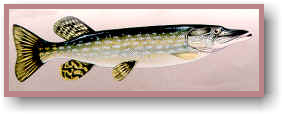
Northern Pike
Esox lucius
Status
Located throughout Labrador, but not on the Island of Newfoundland.
Habitat
Prefer clear, warm, slow, meandering, heavily vegetated rivers; or warm, weedy bays or lakes.
Range
Occur in all provinces.
Food
Translation of the pike’s scientific name from Latin to English is “water wolf.” This name is suitable as the pike is a voracious predator and will eat anything that comes across its path
Appearance
Rows of yellow, bean-shaped spots on green back and sides; larger individuals are dark gray; body shaped for the speed it requires to ambush its prey.
Breeding Biology
Northern Pike spawn in spring, when ice first melts in May, and water temperatures are roughly 4.4oC -11.1oC. Spawning takes place in daylight hours in heavily vegetated bays, lakes and inlets. The larger spawning female is usually paired with one or two males.
Spawning pairs will swim through and over vegetation that, at times, is no deeper than seven inches. The male and female roll at irregular intervals, exposing their vents, and milk and eggs are extruded. Spawning is repeated many times over a two- to five-day period. Pike do not build nests, and eggs are usually scattered at random, with 50 to 60 eggs extruded during each spawning event. Female pike roughly carry 9,000 eggs per pound of body weight. One of the highest recorded egg numbers for a single fish was 595,000 eggs. In general, just more than 50 per cent of eggs will become fertile, but the number of surviving young is very low. Eggs will hatch in about 14 days.
